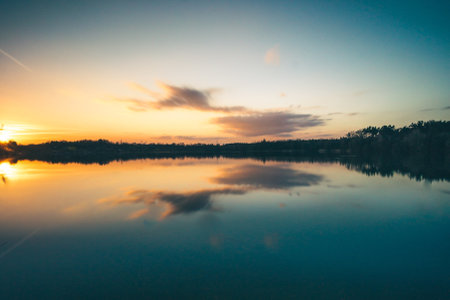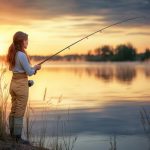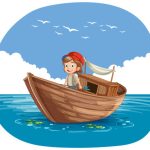1. Choosing the Perfect Fishing Spot
Planning a family fishing trip starts with picking the right location. Across the United States, there are countless lakes, rivers, and coastal areas that offer fun, safe, and accessible options for anglers of all ages. Whether youre introducing your kids to fishing or just enjoying a relaxing weekend on the water, choosing a family-friendly spot is key to creating lasting memories.
What Makes a Fishing Spot Family-Friendly?
When searching for the perfect place, consider these important factors:
- Accessibility: Look for places with easy parking, restrooms, and level ground—especially if youre bringing young children or elderly family members.
- Amenities: Picnic tables, shaded areas, bait shops, and nearby food options can make the day more enjoyable.
- Safety: Calm waters like small lakes or slow-moving rivers are safer and more manageable for beginners.
- Fish Species: Locations stocked with beginner-friendly fish like bluegill, bass, or trout make it easier (and more fun) for everyone to catch something.
Top Family-Friendly Fishing Spots in the U.S.
Here’s a quick guide to some great fishing destinations across different regions of the country:
| Region | Location | Main Fish Species | Amenities |
|---|---|---|---|
| Northeast | Lake Winnipesaukee, NH | Trout, Bass | Boat rentals, picnic areas, public restrooms |
| Southeast | Lake Lanier, GA | Crappie, Catfish | Camping sites, playgrounds, marinas |
| Midwest | Lakes of the Ozarks, MO | Bass, Bluegill | Lodges, boat ramps, family resorts |
| Southwest | Payson Lakes, AZ | Rainbow Trout | Campsites, picnic tables, easy shoreline access |
| West Coast | Cascade Lake, CA | Bass, Trout | Bait shops nearby, scenic views, hiking trails |
| Coastal Areas | Tampa Bay, FL | Redfish, Snook | Piers with railings, tackle rentals, food stands |
Tips for Finding Your Own Local Spot
Check State Wildlife Websites
Most state fish and wildlife departments have interactive maps and lists of local fishing spots that include information on fish species and facilities.
Use Apps and Online Communities
Fishing apps like Fishbrain or websites like TakeMeFishing.org can help you find user-rated spots near you and provide insight into what people are catching there.
Ask Around Locally
Bait shops and local anglers are often happy to share tips about kid-friendly lakes or hidden gems that may not be widely known.
A Quick Checklist Before You Go:
- PFDs (life jackets) for kids and non-swimmers
- Sunscreen and insect repellent
- Plenty of water and snacks
- A basic tackle box with bobbers and hooks sized for panfish or trout
- A cooler for keeping your catch fresh—or your drinks cold!
Selecting the right spot is step one to making your family fishing trip enjoyable. With a little planning and the right location, you’ll be set up for a day full of laughs, learning moments, and maybe even a few big catches.
2. Gear Up: Family-Friendly Fishing Equipment
Getting the right fishing gear is key to making your family fishing trip fun and stress-free. Whether youre casting a line for the first time or introducing your kids to the joys of angling, choosing simple, safe, and affordable equipment can make all the difference.
Keep It Simple for Beginners
For kids and beginners, theres no need to go overboard with fancy gear. A basic spin-casting rod and reel combo is perfect for starting out. These are easy to use, tangle less often, and are just the right size for smaller hands.
Recommended Starter Kits
| Starter Kit | Best For | Includes | Approx. Price |
|---|---|---|---|
| Kids Spincast Combo | Ages 4-10 | Rod, reel, line, practice casting plug | $20 – $30 |
| Beginner Tackle Box Set | First-time anglers | Bbobbers, hooks, sinkers, lures | $15 – $25 |
| Family Fishing Bundle | All ages | Multiple rods/reels, tackle kit, storage case | $50 – $100 |
Safety First!
Safety should always come first—especially when kids are involved. Life jackets are a must near any body of water. Make sure each child wears a properly fitted U.S. Coast Guard-approved life vest. Also consider sunglasses and hats to protect from sun exposure, and dont forget sunscreen!
Top Safety Essentials Checklist:
- Life jackets (one per person)
- Sunscreen (SPF 30 or higher)
- Sunglasses with UV protection
- Bug spray for keeping mosquitoes away
- A small first-aid kit for minor cuts or scrapes
Make It Fun and Engaging
The goal is to create great memories—not to catch trophy fish. Choose colorful lures or bait that are fun for kids to use. Let them be part of the setup process so they feel involved. Consider bringing along snacks, music, or even a small net for exploring other aquatic critters while waiting for a bite.
Pro Tip:
If youre unsure about what to buy, many outdoor stores like Bass Pro Shops or local bait shops offer helpful staff who can guide you toward kid-friendly options without breaking the bank.
The right gear can turn a simple day at the lake into an unforgettable adventure filled with laughs, learning, and maybe even a few fish stories to tell back home.
![]()
3. Planning a Successful Fishing Trip
Organizing a family fishing trip can be just as exciting as the trip itself—especially when you plan ahead to make sure everyone has a great time. A little preparation goes a long way in creating a stress-free, memory-filled adventure on the water.
Check Local Fishing Regulations
Before heading out, its important to know the rules of the area where you’ll be fishing. Each state in the U.S. has its own set of fishing regulations, including licensing requirements, catch limits, and seasonal restrictions. You can usually find this information on your state’s fish and wildlife website or through local bait and tackle shops.
Helpful Resources for State Regulations:
| State | Fishing License Info |
|---|---|
| California | wildlife.ca.gov/Fishing |
| Florida | myfwc.com/license/recreational/ |
| Texas | tpwd.texas.gov/fishboat/fish/ |
Pack the Essentials
A well-packed bag means fewer worries once youre by the water. Make sure to include items that will keep everyone comfortable and safe while fishing.
Family Fishing Trip Packing List:
| Category | Items to Bring |
|---|---|
| Fishing Gear | Rods, reels, tackle box, bait or lures, extra line, fishing net |
| Comfort & Safety | Sunscreen, hats, sunglasses, bug spray, first-aid kit, life jackets (especially for kids) |
| Snacks & Drinks | Bottled water, sandwiches, fruit, granola bars, cooler with ice packs |
| Extras for Fun | Cameras or phones for photos, travel games, books or coloring supplies for younger kids during downtime |
Watch the Weather Forecast
Weather can change quickly—especially near lakes or coastal areas. Check the forecast a few days in advance and again the morning of your trip. Look out for wind speed, chance of rain, and temperature changes so you can dress appropriately and stay safe.
Create a Flexible Itinerary
The key to keeping all family members happy is flexibility. Plan your day around peak fishing times like early morning or late afternoon but leave room for breaks and activities like swimming or exploring nearby trails. If younger kids lose interest in fishing after an hour or two, having backup activities will keep them engaged without cutting the trip short for everyone else.
Sample Itinerary for a Family Fishing Day:
| Time | Activity |
|---|---|
| 7:00 AM – 9:00 AM | Morning fishing session (cooler temps and active fish) |
| 9:00 AM – 10:00 AM | Snack break and casual exploring/hiking nearby trails |
| 10:00 AM – 12:00 PM | Second round of fishing or switch to other water fun (canoeing/swimming) |
| 12:00 PM – 1:00 PM | Lunchtime picnic at a scenic spot with shade |
A successful family fishing trip comes down to thoughtful planning that balances structure with spontaneity. By taking care of the details ahead of time—from gear and licenses to weather and snacks—you’ll create an experience that everyone in your family will remember fondly for years to come.
4. Fishing Techniques for All Ages
When it comes to family fishing trips, using simple and age-appropriate techniques can make all the difference. Whether youre teaching your toddler how to hold a rod or helping your teenager learn to cast, there are fun and effective methods for every age group. Let’s break down a few go-to strategies that are easy to learn, safe to use, and perfect for building confidence on the water.
Bobber Fishing: A Beginner’s Best Friend
Bobber fishing is one of the easiest ways to introduce kids and beginners to the sport. It’s a relaxed style that lets them visually track when a fish bites—making it both fun and rewarding.
Why It Works:
- Simple setup: Just a hook, bobber, sinker, and live bait like worms or minnows.
- Visual feedback: The bobber dips when a fish bites, making it exciting for young anglers.
- Less casting required: Great for smaller kids who aren’t ready to cast far yet.
Casting: For Older Kids and Teens
Once your child gets the hang of fishing basics, casting is the natural next step. It gives them more control over where their bait lands and adds a little action to the experience.
Tips for Teaching Casting:
- Start with a spin-cast reel—it’s easier for beginners than a baitcaster or spinning reel.
- Use practice plugs in an open space before hitting the water.
- Keep instructions short and clear—demonstrate first, then let them try it themselves.
Recommended Fishing Methods by Age
| Age Group | Recommended Technique | Why It Works |
|---|---|---|
| Toddlers (3-5) | Bobber fishing from shore or dock | Safe, visual, and requires minimal effort |
| Younger Kids (6-9) | Bobber fishing + basic casting practice | Keeps them engaged with some movement involved |
| Tweens & Teens (10+) | Casting with lures or bait; learning retrieval techniques | Adds skill-building and excitement as they grow confident |
| Adults | Casting, trolling, fly fishing depending on interest | Customizable based on skill level and desired challenge |
Keeping Kids Excited and Engaged
The key to keeping kids interested in fishing is letting them be hands-on. Give them small responsibilities like holding the net, choosing bait, or releasing the fish back into the water. Celebrate every catch—no matter the size—and take breaks for snacks or swimming if attention spans start to fade. Make it more about the adventure than just catching fish.
Fun Tip:
Create a “First Catch Certificate” or bring along a journal where kids can draw pictures or write about what they caught that day. These little traditions help build lasting memories around fishing together as a family.
5. Making It Memorable
Fishing trips are about more than just catching fish—theyre about creating stories, laughter, and lifelong memories with your family. Whether youre out on the lake or winding down around the campfire, there are plenty of ways to turn a simple outing into something unforgettable.
Capture the Moments
Dont forget your camera or smartphone! Taking photos is one of the easiest and most fun ways to preserve memories. Encourage everyone to snap pictures throughout the trip—silly selfies, big catches, scenic shots, and even those “almost caught it” moments. Create a shared album afterward so everyone can relive the fun.
Photo Ideas:
- Catch of the Day: Pose with your biggest (or smallest!) catch.
- Before & After: Take a group photo at the start and end of the trip.
- Nature Shots: Capture wildlife, sunsets, and peaceful water views.
- Candid Moments: Snap pics during funny or unexpected situations.
Play Games On and Off the Water
Keep things exciting with games that add extra fun to your fishing trip. These activities help pass time between bites and keep kids engaged without relying on screens.
| Game | Description | Where to Play |
|---|---|---|
| Fishing Bingo | Create cards with fish types, gear, and actions (e.g., “Someone catches a bass”) | On the boat or dock |
| I Spy: Nature Edition | Spot animals, boats, or landmarks around you | While waiting for a bite |
| Tall Tale Challenge | Make up wild fishing stories—funniest one wins! | Around the campfire or during lunch breaks |
Create Traditions Together
The best memories often come from small traditions that become part of every trip. Whether its cooking up a fish fry on the last night or telling stories under the stars, these rituals give everyone something special to look forward to each year.
Ideas for Family Fishing Traditions:
- The First Catch Celebration: Cheer for whoever reels in the first fish of the day.
- Campsite Cooking Night: Prepare dinner together using your catch of the day.
- “Fish Tales” Hour: Everyone shares their favorite moment or story from the trip.
- Silly Hat Day: Bring fun hats to wear while fishing—it makes for great photos!
Bonding Beyond the Rod and Reel
A successful fishing trip isn’t just about landing trophy fish—it’s about spending quality time together. Use quiet moments on the water to talk, share stories, or teach your kids life lessons through nature. These are moments that will stick with them long after the trip is over.
Tip:
If you’re traveling with younger kids, let them be “captain” for a day—choose where to fish next, help steer a small boat (with supervision), or lead a sing-along. Giving them little responsibilities makes them feel involved and proud.
No matter how many fish you catch, it’s these shared experiences that turn a family fishing trip into cherished memories for years to come.


